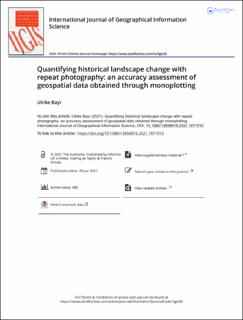| dc.contributor.author | Bayr, Ulrike | |
| dc.date.accessioned | 2021-06-18T12:28:25Z | |
| dc.date.available | 2021-06-18T12:28:25Z | |
| dc.date.created | 2021-01-22T11:06:55Z | |
| dc.date.issued | 2021-01-20 | |
| dc.identifier.citation | International Journal of Geographical Information Science (IJGIS). 2021, . | en_US |
| dc.identifier.issn | 1365-8816 | |
| dc.identifier.uri | https://hdl.handle.net/11250/2760181 | |
| dc.description.abstract | Traditional landscape photographs reaching back until the second half of the nineteenth century represent a valuable image source for the study of long-term landscape change. Due to the oblique perspective and the lack of geographical reference, landscape photographs are hardly used for quantitative research. In this study, oblique landscape photographs from the Norwegian landscape monitoring program are georeferenced using the WSL Monoplotting Tool with the aim of evaluating the accuracy of point and polygon features. In addition, the study shows how the resolution of the chosen digital terrain model and other factors affect accuracy. Points mapped on the landscape photograph had a mean displacement of 1.52 m from their location on a corresponding aerial photograph, while mapped areas deviated on average 5.6% in size. The resolution of the DTM, the placement of GCPs and the angle of incidence were identified as relevant factors to achieve accurate geospatial data. An example on forest expansion at the abandoned mountain farm Flysetra in Mid-Norway demonstrates how repeat photography facilitates the georectification process in the absence of reliable ground control points (GCPs) in very old photographs. | en_US |
| dc.language.iso | eng | en_US |
| dc.publisher | Informa UK Limited, trading as Taylor & Francis Group. | en_US |
| dc.rights | Attribution-NonCommercial-NoDerivatives 4.0 Internasjonal | * |
| dc.rights.uri | http://creativecommons.org/licenses/by-nc-nd/4.0/deed.no | * |
| dc.title | Quantifying historical landscape change with repeat photography: an accuracy assessment of geospatial data obtained through monoplotting | en_US |
| dc.type | Peer reviewed | en_US |
| dc.type | Journal article | en_US |
| dc.description.version | publishedVersion | en_US |
| dc.rights.holder | © 2021 The Author(s). | en_US |
| dc.source.pagenumber | 21 | en_US |
| dc.source.journal | International Journal of Geographical Information Science (IJGIS) | en_US |
| dc.identifier.doi | 10.1080/13658816.2021.1871910 | |
| dc.identifier.cristin | 1877022 | |
| dc.relation.project | Norges forskningsråd: 194051 | en_US |
| cristin.ispublished | true | |
| cristin.fulltext | original | |
| cristin.qualitycode | 2 | |

